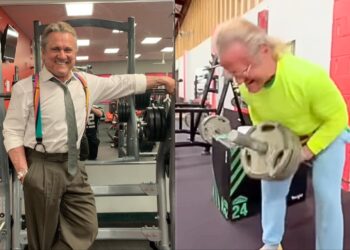When it comes to back training, most exercisers focus on their lats, rhomboids, traps, and erector spinae. This makes a lot of sense given that these are the most prominent, powerful back muscles.
But, in terms of function and performance, there is another muscle group that deserves your attention – the thoracic extensors.
In this article, we explain why and how you should train these essential back muscles.
Thoracic Extensors – Anatomy and Function
Your spine is made up of 33 individual bones called vertebrae. Each one is a slightly different shape and size. Most are separated by intervertebral disks, and they’re connected by ligaments and numerous muscles. The spine is a very complex structure!
The spine can be divided into five sections:
- Cervical spine – neck (7 vertebrae)
- Thoracic spine – upper back (12 vertebrae)
- Lumbar spine – lower back (5 vertebrae)
- Sacrum – pelvis (5 vertebrae – fused/immobile)
- Coccyx – your “tailbone” (4 vertebrae – fused/immobile
The cervical, thoracic, and lumbar spine are capable of several different movements: flexion, lateral flexion, extension, and rotation. Each spinal segment and movement is controlled by different muscles.
Level Up Your Fitness: Join our 💪 strong community in Fitness Volt Newsletter. Get daily inspiration, expert-backed workouts, nutrition tips, the latest in strength sports, and the support you need to reach your goals. Subscribe for free!
If you want a stronger lower back, there are lots of exercises to choose from, most of which also involve your hamstrings and glutes. Good options include hyperextensions, good mornings, and Romanian deadlifts.
Or, if you want a stronger neck, you can use a head harness or try a wrestler’s bridge. However, outside of football players, boxers, and the occasional pencil neck, not many people want or need to make their necks bigger or more muscular.
And then there is the thoracic spine. This is the section of the spine to which your ribs are attached.
In squats and deadlifts, and many upper body exercises, you need to keep your thoracic spine rigid to prevent your upper back from rounding. Pulling your shoulders down and back are good cues for activating your thoracic extensors. However, if these muscles are weak, you may find that, despite your best intentions, your upper back rounds anyway.
Long periods of sitting with a hunched back can leave the T-spine extensor muscles stretched and weak, so this is a common problem for lifters who are also office warriors.
The main muscles that control your thoracic spine include:
- Serratus posterior inferior
- Serratus posterior inferior
- Transverospinalis
- Iliocostalis*
- Longissimus*
- Spinalis*
* Part of the erector spinae group of muscles.
Why and How to Train the Thoracic Extensors
If you find that your upper back tends to round during deadlifts, or you have problems maintaining good upper back posture during front squats, your thoracic extensors are probably weak. You will benefit from targeting these muscles with some specific exercises.
And therein lies the problem; while most people know only too well how to train their lats, rhomboids, and traps, very few know how to target their thoracic extensor muscles. You may even find that you cannot identify and move your T-spine without performing a lot of lumbar flexion.
Don’t worry; we’re here to help!
In the next section, you’ll find seven exercises for building stronger thoracic extensors. However, to get the most from these exercises, you’re going to have to do something that is borderline sacrilegious in almost any other exercise – lift with a rounded back.
But, to train your T-spine extensors, you need to flex and extend your upper spine. That said, it’s essential to differentiate between moving your thoracic spine and your lumbar spine.
While flexion and extension of the T-spine is necessary to train your thoracic extensors, rounding of your lower back is best kept to a minimum. Imagine you are doing crunches for your upper abs, and you’ll soon understand the difference.
If you feel any of our thoracic extensor exercises in your lower back, you are probably flexing the wrong part of your spine or using too much weight. Either way, make sure you can feel your thoracic extensors working while keeping lumbar flexion to a minimum.
7 Exercises for Stronger Thoracic Extensor Muscles
Now you understand the need for stronger thoracic extensor muscles, these are some of the best exercises for achieving that goal…
1. Upper back stability ball extensions
The great thing about this exercise is that it helps guide your movement to ensure that you’re really focusing on your thoracic extensors and not using your lower back too much. If you find it hard to separate your T-spine from your lumbar spine, this exercise should help.
How to do it:
- Kneel on the floor behind your stability ball. Lean forward and place your abdomen and chest on the ball. Put your hands on your temples. Drape your upper body around the ball.
- Lift your chest and shoulders and extend your thoracic spine without moving your lower back.
- Hold the top position for 3-5 seconds, return to the starting position, and repeat.
- This exercise is good for thoracic mobility and strength.
2. Front squat iso-hold
While front squats are undeniably a lower body exercise, your upper body is strongly involved too. A lot of lifters find that their upper back rounds during heavy front squats, which suggests a weakness of the thoracic extensors.
Level Up Your Fitness: Join our 💪 strong community in Fitness Volt Newsletter. Get daily inspiration, expert-backed workouts, nutrition tips, the latest in strength sports, and the support you need to reach your goals. Subscribe for free!
Front squat iso-holds make use of this common phenomenon. Holding a barbell in a front rack position provides a static but challenging workout for the thoracic extensor muscles.
How to do it:
- Put a barbell in your squat rack at about shoulder height.
- Walk forward and put your anterior (front) deltoids against the bar. Grip the bar with your hands just wider than shoulder-width apart.
- Push your elbows forward and under the bar so your upper arms are parallel to the floor. The bar should rest against your neck, but it should not press on your throat.
- Brace your core and pull your shoulders down and back. Unrack the bar and take 1-2 steps back and into a shoulder-width stance.
- Hold this position while keeping your chest up and shoulders down and back.
- Rerack the bar, rest, and repeat.
3. Seated good morning
Regular good mornings are a great way to strengthen your entire posterior chain. They’re so-called because, when you do them, you look like you are bowing to greet someone. However, done seated, your hips remain stationary, and more of the movement comes from flexing and extending your upper spine.
How to do it:
- Rest and hold a barbell across your upper traps. Sit on an exercise bench with your legs bent and feet flat on the floor. Brace your core.
- Keeping your butt firmly planted on the bench, lean forward while ensuring most of the movement comes from your upper back. While your lower back will flex, try to maintain at least a slight lumbar curve.
- Sit up straight and repeat.
- You can also do this exercise with a safety squat bar.
4. Safety squat bar good morning
Using a safety squat bar positions the weight higher on your shoulders, increasing the need to stabilize your thoracic spine as you lean forward. In addition, the weight is in front of your body, further increasing the load on your thoracic extensors.
Take care when doing this exercise to ensure most of the movement comes mainly from your upper back and not from flexing your lumbar spine or hips.
How to do it:
- Hold a safety squat bar across your upper back and grab the handles. Stand with your feet roughly shoulder-width apart, knees slightly bent. Brace your core.
- Flex your upper spine and lean forward. Try to maintain your lumbar arch.
- Stand up straight and repeat.
- You can also do safety squat bar good mornings seated, as per exercise #1.
5. Chain/resistance band good morning
This good morning variation is ideal for strengthening your thoracic extensors without overloading your lower back. The tension is lower as you lean forward but increases are you approach upright. Using chains or bands is a spine-friendly alternative to barbell and safety bar good mornings.
How to do it:
- Stand on your resistance band and place it over your head and behind your neck. Alternatively, drape a chain over the back of your neck, so the ends rest on the floor.
- Stand with your feet roughly shoulder-width apart, knees slightly bent.
- Flex your upper back while maintaining your lumbar curve. Lean forward and then stand up straight against the resistance offered by the band/chain.
6. Seated kettlebell deadlift
This exercise ensures you use the same range of motion for each and every rep. It’s also ideal for home exercisers who may not have the space or a barbell for movements like seated good mornings. It’s also pretty low back-friendly.
How to do it:
- Sit on a sturdy chair or the end of an exercise bench. Place your feet about shoulder-width apart. Sit up straight and hold a kettlebell between your legs. Brace your core.
- Rounding your upper back more than your lumbar spine, lean forward and lower the kettlebell to the floor.
- Sit up straight and repeat.
7. Jefferson curl
The Jefferson curl (probably NOT named after president Thomas Jefferson!) is a mobility and strengthening exercise for the entire spine, including the T-spine. While some people like to do these with heavy weights, light to moderate weights are best to minimize your risk of injury. You can even do them unweighted to focus more on mobility than strength.
How to do it:
- Stand with your feet hip-width apart, legs straight, and hands in front of your hips. Hold a light kettlebell or dumbbell.
- Starting with your neck, roll down and reach toward the floor, flexing one vertebra at a time. Focus on moving your spine segmentally.
- Leading with your lumbar spine, stand up straight, again moving one vertebra at a time.
Thoracic Extensor Exercises – Wrapping Up
There is no denying the importance of your posterior chain. It’s crucial for better posture and improved athletic performance. But, when most people think about this vital group of muscles, they tend to focus on the hamstrings, glutes and lower back.
This makes a lot of sense given that these muscles are your body’s engine room, responsible for generating power. But power is nothing without stability. If you want to maximize your performance in exercises like deadlifts, squats, and even biceps curls, you need to train your upper back too, and specifically your thoracic extensors.
To the untrained eye, many thoracic extensor exercises look like you’re using poor technique. After all, they involve purposely rounding your spine. However, that’s one of the movements of the thoracic spine. If you’re going to strengthen these all-important muscles, you need to flex and extend your upper back.
But, you need to keep lumbar flexion to a minimum. It’s going to move, but you should definitely avoid rounding your lower back. Instead, do your best to maintain at least a degree of lumbar arch. Bracing your core will undoubtedly help.
That way, you can strengthen your thoracic extensors without wrecking your lower back.
Interested in measuring your progress? Check out our strength standards for Good Morning, Deadlift, Romanian Deadlift, and more.









